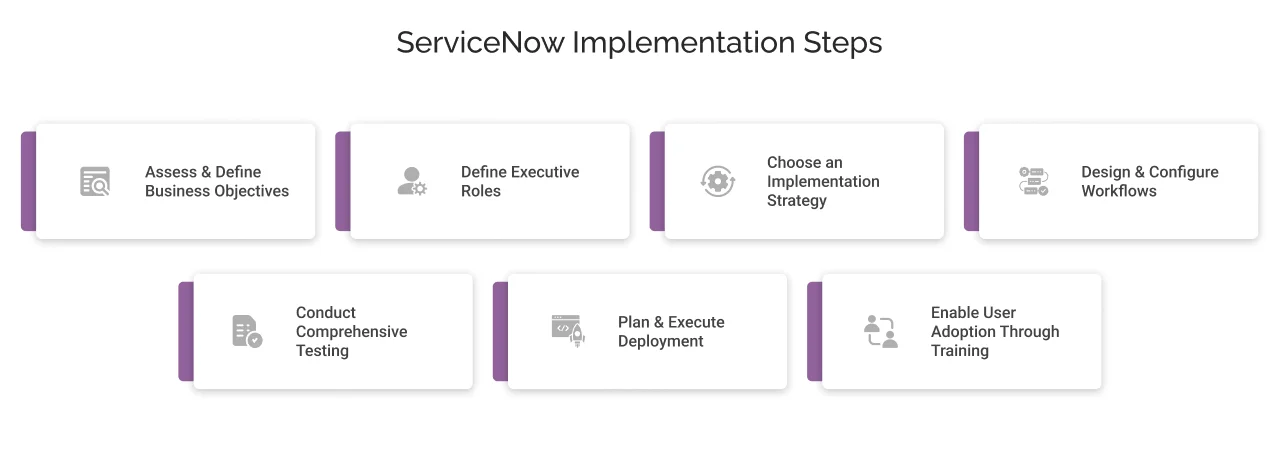The Complete Guide to ServiceNow Implementation
Table of Contents
ServiceNow implementation can fall short without the right strategy. Organizations often struggle with unclear roadmaps, budget overruns, integration complexities, and low user adoption.
So, how do you ensure a successful ServiceNow rollout?
Don’t worry! This blog outlines pre-implementation considerations, step-by-step implementation process, and pricing insights to ensure a smooth & successful implementation.
Let’s begin by discussing the key pre-implementation considerations.
Pre-Implementation Considerations
Planning
Planning is the foundational phase where the strategy, scope, objectives, and resources for the ServiceNow implementation are defined. It includes:
- Understanding the organization’s strategic objectives from this platform.
- Deciding on the ServiceNow modules to implement, such as ITSM, ITOM, CSM, and HRSD.
- Defining the budget for licensing, ServiceNow consulting & implementation, training, and ongoing maintenance.
- Identifying potential risks (such as data migration challenges, resistance to change, etc.)
- Ensure contingency plans are in place in case of project delays or unforeseen situations.
Requirement Gathering
Requirement gathering is essential to define what changes you want to make. It includes:
- Map out the existing business processes and workflows.
- Prioritize the requirements (ensuring that critical business processes are prioritized in the initial implementation.)
Setting Up Instances
- Order Dev/Prod/Test instances from ServiceNow.
- Configure basic company settings (such as company info, time zone, support email, etc.)
- Enable required modules (ITSM, HRSD, CSM)
Step-by-Step Guide to Implementing ServiceNow in Your Organization
While the exact implementation roadmap can vary depending on organization size and chosen partner, below are the general steps most organizations follow for successful implementation:


Step 1: Measure and Decide Your Business Goals
Having the surety of business goals and a checklist for implementation success (in terms of improving employee experience, reducing service outages, or something else) is necessary and, at the same time, challenging. You can document your objectives and target outcomes, like;
- Reducing IT support and maintenance costs (by 20%)
- Improve issue resolution speed (by 30%)
- Enabling self-service and automation (increase the usage by 25%)
Step 2: Define the Executive role
First, identify the right executive role (avoiding this may lead to conflicts in resource availability) who will have regular insights into company goals and have the authority to remove barriers to the success of implementation. Also, get their commitment as they have a number of priorities on their calendar.
Step 3: Leverage Expertise of Certified ServiceNow Professionals
ServiceNow implementation requires deep platform knowledge and a clear understanding of how its modules align with your organizational process. It’s essential to have certified professionals who can manage configurations and integrations effectively.
If you have in-house ServiceNow specialists, they can lead the implementation and avoid common pitfalls. Otherwise, you can collaborate with an experienced implementation partner who brings proven experience and industry best practices to the project.
Step 4: Take a Phased Approach
It is a big decision whether you are choosing a big bang or a phased approach. A big bang approach can be problematic for organizations that have complex systems. At the same time, a phased approach incrementally adds features that typically yield better results.
Step 5: Map the Strong Foundation
This step is about laying a strong foundation that supports your growth and minimizes your headaches. This also means lower maintenance costs, easier adoption of ServiceNow features, and most importantly, more efficient, quicker initial implementation. So:
- Prioritizing OOTB (out-of-the-box) features provides you with a strong foundation.
- Further, you can communicate with the stakeholders if they require more complex features and workflows to ease their work.
- If you have a ServiceNow Architect already, then you can define the custom development needs (ensure it fulfils compliance needs and unique business requirements that OOTB cannot handle.)
This step is crucial as customization looks tempting, which can tailor things, but excessive customization is complex to maintain.
Step 6: Implementing Workflows
Business Rules: Implement custom business rules for automation of tasks, data processing, and notifications.
Workflows: Design workflows to automate approvals, task routing, and notifications using Flow Designer or Workflow Editor.
Client Scripts & UI Policies: Customize user interfaces and client-side behavior using scripts and UI policies.
Step 7: Testing
Perform unit testing to validate individual configurations such as business rules, workflows, and UI elements.
Test the system’s performance, including load testing and scalability in the sandbox environment.
Step 8: Deployment to Production
- Deploy the system to the production environment.
- Migrate data from staging or development environments to production.
- Transition all configurations, scripts, and workflows to production.
Step 9: Provide Training for Success
After implementing ServiceNow, your team needs thorough training to navigate platform complexities and ensuring lasting success. Training your end users, administrators, and maintenance teams enables them to use the platform effectively and keep it performing optimally after go-live.
Many organizations also choose to partner with ServiceNow managed service providers to ensure continuous monitoring, optimization, and platform scalability.
ServiceNow Implementation Cost
Cost to implement ServiceNow includes licensing fees paid to ServiceNow, and professionals fees if you’re seeking help of a ServiceNow partner. Let’s discuss each of these components:
Licensing Costs
Per-User, Per-Month: ServiceNow is not a one-size-fits-all platform; its pricing is flexible and structured on a per-user, per-month basis.
Module-based: The price depends on the module and required license type.
To understand the full pricing and accurate cost structure according to your specific business needs, you can:
- Contact ServiceNow certified partners; or
- Contact ServiceNow for a detailed breakdown
Partners have vast experience and can help you save licensing costs. In addition, organizations should also consider the ongoing ServiceNow costs when budgeting (such as license renewals, support fees, and additional modules costs, as needed).
Professional fees
If you’re seeking help of a ServiceNow partner, you’ll incur a professional fee that depends on the type of engagement you have with the partner. For instance, you could hire a partner for an end-to-end ServiceNow implementation project with fixed cost, or you could also engage their resources like admins, developers, architects, quality assurance engineers, business analysts, project managers etc. at hourly rates.


Conclusion
A successful ServiceNow implementation requires strategic planning, clear objectives, expert guidance, and phased execution. For organizations seeking a faster rollout, starting with the Out-of-the-Box (OOTB) functionality is recommended. As the platform implementation matures, configurations and integrations can be introduced to align with evolving organizational needs.
If you’re seeking help with implementing ServiceNow, you can leverage the expertise of Cyntexa, a registered ServiceNow Consulting & Implementation partner. Our ServiceNow implementation services help organizations streamline workflows, enhance service delivery, and accelerate digital transformation. With our certified experts and proven methodologies, Cyntexa ensures scalable implementations aligned with your organizational goals.
Schedule a consultation call today!
Don’t Worry, We Got You Covered!
Get The Expert curated eGuide straight to your inbox and get going with the Salesforce Excellence.
AUTHOR
Shubham
Service Cloud, Salesforce Managed Packages
With over 5 years of experience, Shubham specialize in curating solutions on Salesforce Service Cloud, Nonprofit Cloud, Consumer Goods Cloud, Managed Packages, and ServiceNow ITSM. He designs and implements end-to-end service solutions that improve operational workflows and ensure seamless integration across enterprise systems. Shubham’s expertise lies in creating secure, efficient, and agile platforms tailored to unique business needs.


Cyntexa.
Join Our Newsletter. Get Your Daily Dose Of Search Know-How








